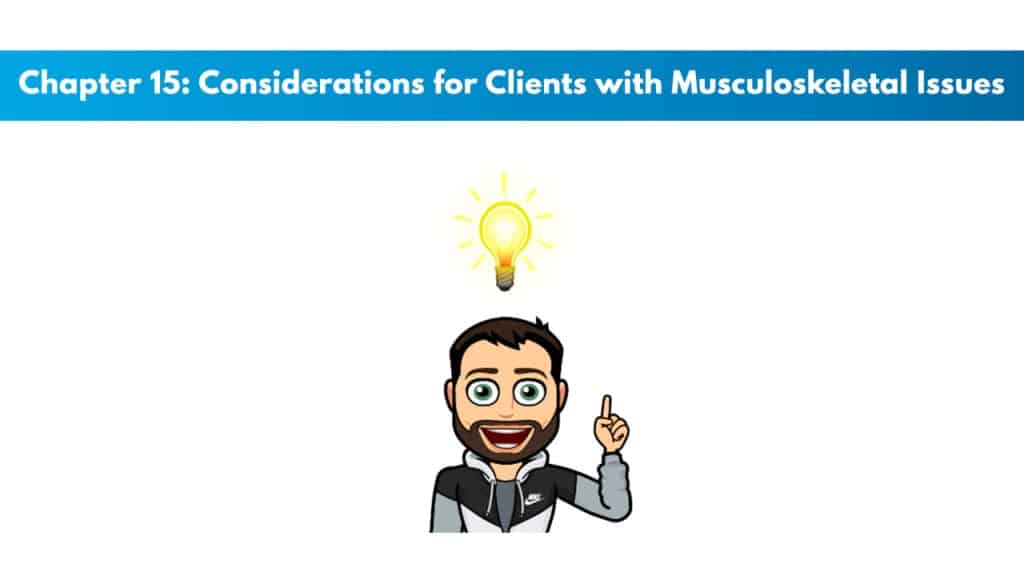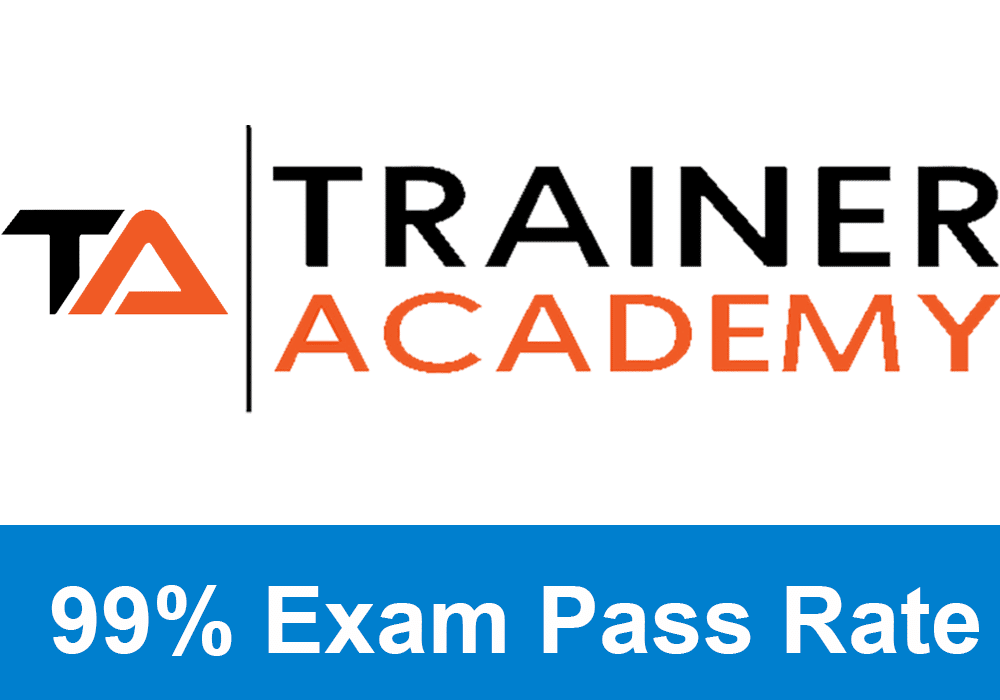
If you have not yet signed up for the ACE CPT certification, receive a big discount here.
Get your copy of the ACE CPT exam cheat sheet.
It helps immensely in your ability to study for the ACE test. This PDF printable one-page sheet gives you a breakdown of the skills and knowledge candidates need to pass the exam.
My PTP students report cutting their ACE study time and effort in half with Trainer Academy.
Benefit from the Exam Pass Guarantee and Retake Fee Guarantee. Plus, take advantage of my current discount code PTPJULY for 35% off the MVP Program (Ends July 7th, 2025).
Try it out for free here to see if it’s right for you, or read my detailed review for further insights.
Chapter Goals:
- Be able to talk about the role and scope of practice of a personal trainer in working with their clients who have or have once had musculoskeletal injuries.
- Be able to discuss the role of pain and how to communicate with clients that are in pain.
- Recognize acute injuries and respond through the application of emergency response protocols.
- Find the signs of chronic injuries or conditions.
- Be able to find when a referral to a healthcare professional is warranted.
- Be able to make a safe and effective exercise program for clients who have historically had common musculoskeletal injuries.
- Use the right exercise programming to avoid injury when training.
Introduction
Through the career of a personal trainer, trainers may have clients that report pain when exercising to arrive with a new injury. Through the careful design of exercise programs and the implementation of these programs, trainers can significantly impact clients with musculoskeletal issues.
Trainers need to keep in mind that the scope of practice of trainers does not include the evaluation, assessment, and diagnosis of muscle or joint pains. When these situations occur, referring clients to a medical professional is important.
Physicians can use tools like MRI, x-ray, and computed tomography. To find the illnesses and identify injuries.
Common Injuries and Reactions to Healing
Exercise is quite important to the overall health and wellness of individuals. People will often seek a trainer expecting to learn safe and effective exercising techniques.
Exclusive PTP CPT Offers |
||
|---|---|---|
Most Popular Cert | Best Online NCCA Cert | Best Study Materials |
Gold Standard Cert | A Good Option | Best CPT for you?  |
Acute and Chronic Injuries The Physiology of Healing
Injuries are possible to occur instantly, or they may manifest themselves over time. Acute injuries can be identified as occurring in one single instance, and chronic injuries are the form that occurs and builds up over the long term.
The phases of healing are what will always occur in the body to help heal and recover.
Phase one of healing is the inflammation phase. This is when there is acute inflammation lasting 3 – 4 days following the injury and may depend on the severity of the injury. There is a lot of swelling and redness and the body uses this to restrict motion and remove things in the tissues that should not be there.
Phase two of healing is the repair phase, and here we have the body repairing the damaged tissues and regenerating them. The phase can overlap with the last phase of inflammation and may last 6 weeks.
Phase 3 of healing is the remodeling phase, and this is where the tissues reorganize themselves along the lines of stress and get back to the level of function they had before being injured.
The Essential Role of Pain
The body uses pain as a quick and clear signal to stop whatever we are doing, as it may hurt us.
Common Acute Injuries
Exercise and sports have many risks for injuries, and trainers must be able to see when a client gets injured and must discontinue the session when warranted.
Muscle strains are common injuries during any form of exertion. These occur when the working muscle is worked beyond its ability, resulting in tearing fibers.
- Grade one strains have some local soreness and cramping as a result and only have a few fibers torn.
- Grade two strains are moderate and have around half the muscle torn. The results are more severe pain and swelling and a greatly reduced range of motion.
- Grade three strains are the most severe, resulting in the muscle being completely torn and possibly requiring surgery to fix it.
Ligament sprains are like muscle strains, but they happen when the ligaments are stressed to the point of tearing. They follow the same grades as the muscle strains regarding their severity. Often these can be seen in non-contact injuries.
There is the possibility for cartilage damage due to them being between and around these muscles and ligaments, which may occur when there is damage to joints.
Bone fractures are possible but much less common in personal trainer settings. It is important to note the possibility of osteoporosis and its effects on the bones of your clients, more so with older adults.
Exclusive PTP CPT Offers |
||
|---|---|---|
Most Popular Cert | Best Online NCCA Cert | Best Study Materials |
Gold Standard Cert | A Good Option | Best CPT for you?  |
Head, neck, and back injuries can occur in the training sessions. Sometimes this is seen in the form of concussions and has to do with falling or dropping something in the session.
Common Overuse Injuries
Overuse conditions are then ones where tissues cannot heal from the stresses we place on them throughout our lives.
Tendinitis, bursitis, and fasciitis are all three forms of overuse that result in inflammation of the tendons, bursa, and fascia, respectively.
Stress fractures are common when there is an imbalance in bone formation and bone resorption. The fractures happen due to compression forces putting repetitive stress on bones that aren’t strong enough to withstand the forces.
Preventing Musculoskeletal Injury
Knowing how to design and periodize programs effectively will be essential for preventing client injuries.
Flexibility and elasticity are factors that increase the risk of injury when decreased levels are present. It can work as the cause or the consequence of injury. Flexibility should be included as part of a regular exercising program.
Warmups are essential to preventing musculoskeletal injuries, as these work to ensure the body has warmed up the right parts and is ready to go through the workout. These warmups should be 5 – 10 minutes in total.
Recovery is one essential part of preventing these injuries, especially when it comes to overuse injuries since they build up over time and result from being unable to heal properly.
Programming Considerations for Clients with Musculoskeletal injuries
The scope of practice for trainers allows us to assess movements and create exercise programs. Trainers should be mindful of the main considerations to be outlined in this chapter.
When pain is present, some extra considerations should be taken to avoid this. Sometimes movements may hurt in a designed program, so trainers should have modifications ready to go when training.
Acute injuries will sometimes require a return to activity protocols from physicians and physical therapists. These say it is ok to return to working out, and it is always better to be safe than sorry.
Chronic injuries and conditions must be considered when designing programs, as these must be addressed and not aggravated further.
Common Conditions of the Upper Extremity
The shoulder is the most mobile and least stable joint in the body, which means it is often injured. Its large range of motion can lead to injuries to many surrounding tissues.
When modifying exercises to improve the function of a client’s shoulder, we should:
- First, we should address any present posture imbalances that may cause decreases in space between the acromion process and the humeral head. This is like rounding off the shoulders or kyphosis.
- Second, we should focus on strengthening the stabilizing muscles connecting to the scapula, like the rotator cuff muscles.
- Next, we need to improve the anterior muscles of the shoulder and the pec major by controlling the pushing movements.
- The last thing to do is introduce activities of the overhead movement and do these in the scapula plane to prevent impingement.
The elbow, wrist, and hand all have issues, mostly regarding repetitive and overuse injuries like carpel tunnel syndrome and similar issues. There is also the possibility of fractures in the small bones of the hand.
Common Conditions of the Spine
Many clients will be found to suffer from neck, mid-back, and lower back problems. This is especially true with the lower back, as we see this as one of the most popular conditions in the US for adults.
Each of these three locations has issues that often involve the vertebrae of the spine or the surrounding muscles.
Disc injuries can be common, especially lower down in the spine.
We must address the imbalances between the right and left sides and then postural deviations. Follow this u with internal and external rotation movements and strengthening the posterior chain.
Common Conditions of the Lower Extremity
The lower extremities control the transmission of all of the ground reaction forces through the body. The main body parts to consider for these conditions will be the hip, knee, ankles, and lower leg.
The knee and ankle are some of the most common injuries in training and sports.
Preventing these injuries will require us to ensure clients have worked on flexibility, mobility, and strength required to do movements as we progress throughout training.

 Have a question?
Have a question? 



Tyler Read
PTPioneer Editorial Integrity
All content published on PTPioneer is checked and reviewed extensively by our staff of experienced personal trainers, nutrition coaches, and other Fitness Experts. This is to make sure that the content you are reading is fact-checked for accuracy, contains up-to-date information, and is relevant. We only add trustworthy citations that you can find at the bottom of each article. You can read more about our editorial integrity here.